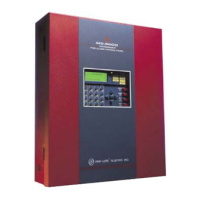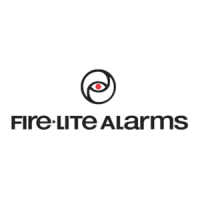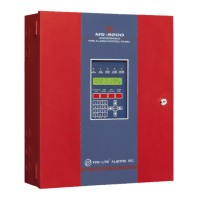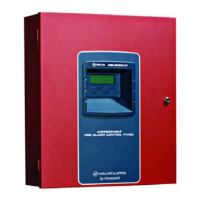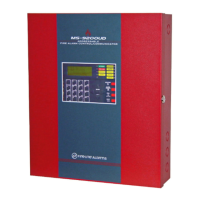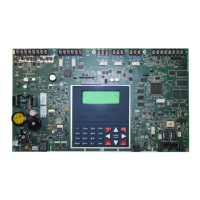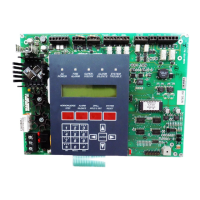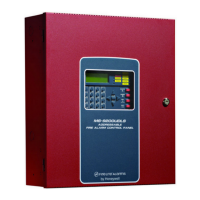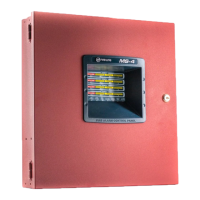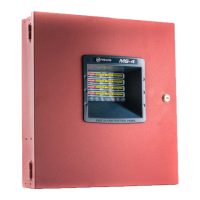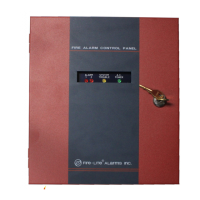Do you have a question about the Fire-Lite MS-9600LS and is the answer not in the manual?
Lists items included in the FACP shipment.
Highlights key functionalities and available system add-ons.
Details technical specifications of FACP components.
Details the front panel display and status LEDs.
Explains the SLC communication loop and output circuits.
Describes the main physical parts of the FACP system.
Lists optional modules and devices for the FACP.
Details the physical installation and mounting procedures for the FACP.
Covers AC and battery power connections and safety.
Describes the FACP's programmable and fixed relays.
Covers the panel's NACs for audible/visual devices.
Details requirements for separating power-limited and nonpower-limited wiring.
Covers installation of optional modules and devices.
Methods for entering programming data via keypad or keyboard.
Overview of user programming levels and methods.
Initial setup, screen navigation, and password management.
Accessing and using the master programming interface.
Adding devices, editing points, and using autoprogram for system setup.
Adding, deleting, or editing module configurations.
Configuring system zones, enabling/disabling, and special purposes.
Configuring SLC loop settings and protocols.
Configuring overall system parameters like time, NACs, relays, and Canadian options.
Verifying loops, managing history, and performing walktests.
Available FACP option modules and their configuration.
Changing system passwords and clearing programming data.
Checking programmed circuits for missing inputs/outputs.
Disabling specific system points.
Viewing and erasing system history.
Checking programmed circuits for missing inputs/outputs.
Performing system walktests.
Setting system time and date.
Configuring system zones and their properties.
Describes the functions of the panel's control buttons.
Explains the meaning of the panel's status LEDs.
Describes the system's state during normal operation.
How the panel indicates and handles trouble conditions.
How the panel indicates and handles alarm conditions.
How the panel indicates and handles supervisory conditions.
Panel behavior for process monitor, hazard, and medical alert conditions.
Integration with mass notification systems.
Zone assignment, disable/enable, waterflow, and detector functions.
Real-time clock functions.
How NACs operate, including coded modes.
Strobe synchronization for notification appliances.
NAC coding, presignal, and positive alarm sequence operations.
System timers for various operations.
Performing system walktests.
Viewing system status and programmed features.
Reading status of individual system points.
Reading zone installation, enablement, and type status.
Reading various system status indicators and configurations.
Introduction to power supply calculations.
Steps to calculate AC branch circuit requirements.
Method for calculating system current draw.
Method for calculating required battery size.
Explains the relationship between input devices, zones, and output devices.
Standards for NFPA 72 compliance.
Connecting FACP dry contacts to transmitters for central station reporting.
Illustrates MBT-1 connection for municipal box trips with silenceable functionality.
Lists wiring requirements for Notification Appliance Circuits.
How control modules manage HVAC shutdown.
How monitor modules interact with HVAC control.
Lists items included in the FACP shipment.
Highlights key functionalities and available system add-ons.
Details technical specifications of FACP components.
Details the front panel display and status LEDs.
Explains the SLC communication loop and output circuits.
Describes the main physical parts of the FACP system.
Lists optional modules and devices for the FACP.
Details the physical installation and mounting procedures for the FACP.
Covers AC and battery power connections and safety.
Describes the FACP's programmable and fixed relays.
Covers the panel's NACs for audible/visual devices.
Details requirements for separating power-limited and nonpower-limited wiring.
Covers installation of optional modules and devices.
Methods for entering programming data via keypad or keyboard.
Overview of user programming levels and methods.
Initial setup, screen navigation, and password management.
Accessing and using the master programming interface.
Adding devices, editing points, and using autoprogram for system setup.
Adding, deleting, or editing module configurations.
Configuring system zones, enabling/disabling, and special purposes.
Configuring SLC loop settings and protocols.
Configuring overall system parameters like time, NACs, relays, and Canadian options.
Verifying loops, managing history, and performing walktests.
Available FACP option modules and their configuration.
Changing system passwords and clearing programming data.
Checking programmed circuits for missing inputs/outputs.
Disabling specific system points.
Viewing and erasing system history.
Checking programmed circuits for missing inputs/outputs.
Performing system walktests.
Setting system time and date.
Configuring system zones and their properties.
Describes the functions of the panel's control buttons.
Explains the meaning of the panel's status LEDs.
Describes the system's state during normal operation.
How the panel indicates and handles trouble conditions.
How the panel indicates and handles alarm conditions.
How the panel indicates and handles supervisory conditions.
Panel behavior for process monitor, hazard, and medical alert conditions.
Integration with mass notification systems.
Zone assignment, disable/enable, waterflow, and detector functions.
Real-time clock functions.
How NACs operate, including coded modes.
Strobe synchronization for notification appliances.
NAC coding, presignal, and positive alarm sequence operations.
System timers for various operations.
Performing system walktests.
Viewing system status and programmed features.
Reading status of individual system points.
Reading zone installation, enablement, and type status.
Reading various system status indicators and configurations.
Introduction to power supply calculations.
Steps to calculate AC branch circuit requirements.
Method for calculating system current draw.
Method for calculating required battery size.
Explains the relationship between input devices, zones, and output devices.
Standards for NFPA 72 compliance.
Connecting FACP dry contacts to transmitters for central station reporting.
Illustrates MBT-1 connection for municipal box trips with silenceable functionality.
Lists wiring requirements for Notification Appliance Circuits.
How control modules manage HVAC shutdown.
How monitor modules interact with HVAC control.
| Type | Addressable Fire Alarm Control Panel |
|---|---|
| Weight | 12 lbs |
| SLC Loops | 1 |
| Operating Voltage | 24VDC |
| Alarm Current | 2.5A |
| Number of Notification Appliance Circuits | 4 |
| Operating Temperature Range | 32°F to 120°F (0°C to 49°C) |
| Relative Humidity | 10% to 93% non-condensing |
| Power Supply | 120/240 VAC, 50/60 Hz |
| Compatibility | Fire-Lite devices |
| NAC Circuits | 4 |
| Maximum Devices per Loop | 159 |
| Battery Charging Current | 1A |
